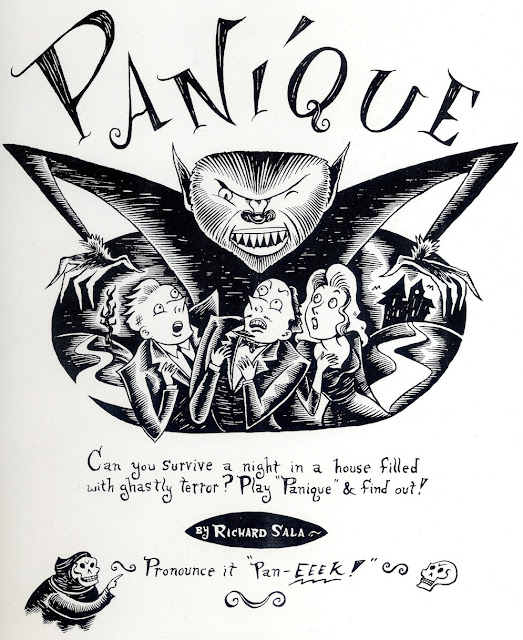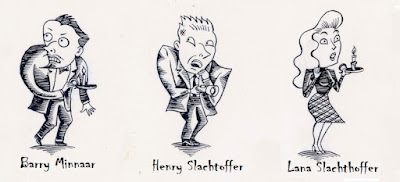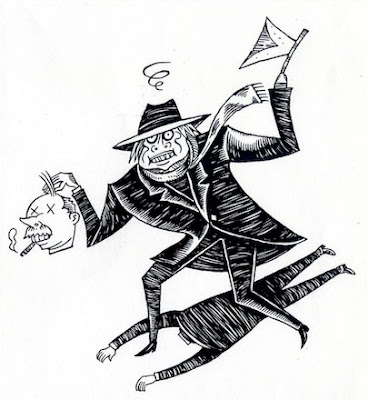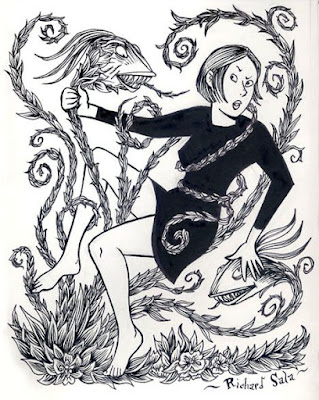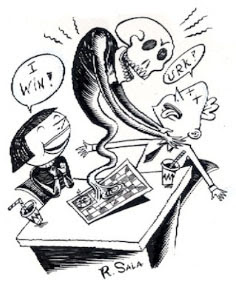SECOND EDITION
Design: Richard Sala & Steve Miller
Editing: Steve Miller
INTRODUCTION
In 1994, artist/writer Richard Sala created a board game for San Fransisco-based publisher Hairy Scary Toys. According to comments from Sala, the game sold dozens of copies ( NUELOW Games-type sale figures) and was generally a disappointment on many levels for him.
At NUELOW Games, we're big fans of Richard Sala's work, and we love the idea of the Panique game. What we didn't love was the rules, some confusing elements of the board, and... well, basically everything but the fun Sala artwork.
But! Games are our thing, so here's a 100 percent unauthorized, copyright-violating Second Edition of Richard Sala's Panique, with a revised board and vastly expanded rules. (If someone out there knows who's in charge of Richard Sala's copyrights and estate, let us know; we'd love to a version of this material for an actual release.)
To play Panique, you need to play are a couple of friends, one or more eight-sided dice; and a print-out of the board, featured immediately below this paragraph. You will also need markers to track the player's character as he or she moves through the house of horror--and you can either print the neat Sala character portraits and make little standees, use meeples from another game, or whatever else might be around the house.
THE GAME BOARD
(click to view a larger version, and to download and print)
(click to view a larger version, and to download and print)
PANIQUE BACK STORY
The will of your late, eccentric millionaire uncle stipulates that in order for you to inherit his fortune--along with the other surviving relatives--you must spend a night in his old, creepy, haunted death-trap of a house. Whoever is still alive when morning comes can share the old man's millions.
You arrive, along with the other relatives, arrive on a stormy night, and are greeted by the sinister servants. In the middle of dinner, before the evening has even gotten truly under way, the power goes out. Then the phone goes dead. The bridge--the only link to town--has been washed away by the storm. The guests and servants begin disappearing, one by one. You decide to set off by yourself and explore the house. If you keep moving through the night, perhaps you can survive until morning.
GETTING READY TO PLAY
Each player places a marker on the space marked "Enter" on the game board; this marker represents an heir trying to survive the night. One 8-sided die should be placed on the boxed circle center-right on the board (the "Circle of Life"). If possible, each player should also have an 8-sided die to roll.
Determine which player will go first by having each of them roll a die. The player with the highest roll goes first. If there are ties, the left-handed player goes first. If rolls are still tied, the oldest, left-handed player goes first.
Panique is intended for 1-3 players, but we think that as many as 5 might have a fun time playing it together.
PLAYING THE GAME
The player who goes first takes a turn by rolling a die and comparing it to the result on the Circle of Life. The player moves his or her marker the number of indicated spaces along the track on the board. When the movement ends, the player must take whatever game actions are listed on the space the movement ended in OR roll on the Lethal Encounter Table to see what might happen If there are no game instructions on the space, the Lethal Encounters Tables to see what happens.
Actions described in a space or rolls against the Lethal Encounters Table are performed only when a marker is placed in a space as a result of the first die roll made by a player on his or her turn.
Once all movements and Life Point adjustments are complete, the next player takes his or her turn. Play order goes to the left around the table.
If two or more markers end a turn in the same space, the players can choose to forego their next turn. Each heir regains 1 Life Point.
If an heir is reduced to 0 Life Points, the player controlling it is out of the game. The first player to be thusly eliminated performs all rolls on the Lethal Encounter Tables.
The game is over when the first player gets his or her marker to the "Leave the House" space, or when only one heir remains. The winner is either the first player to have an heir escape to see the sunrise, or when only one heir remains alive. (Play can still continue if only one player remains with a living heir, in case everyone wants to see if anyone can survive the night.)
THE LETHAL ENCOUNTER TABLES
As the endangered heirs roam through the house of horrors, they encounter deadly foes and the occasional ally.
At the beginning of the game, each heir (represented by the marker the player moves along the track on the game board) has 3 Life Points. Each encounter in the house can either take away a Life Point or restore one previously lost (to the starting maximum of 3).
Whenever a player's marker lands on a space with no game-related instructions, the player to his or her left rolls the die on the Circle of Life to see who or what is encountered and consults the table to see what happens.
Encounter Table
1. The Ally.
2. The Black Cat
3. The Butler
4. The Ghost
5. The Mad Doctor
6. The Mad Killers
7. The Man-Eating Plant
8. The Monster
Detail Tables
1. The Ally
An inhabitant of the house, possibly a fellow guest, tries to assist you.
1-2. A teen girl in a purple dress and no shoes offers to lead you to safety. She is promptly seized by smokey tentacles and dragged into a one-way secret door. Gain 1 Life Point.
3-4. A portly man with a white beard rushes into the room, just in time to engage a knife-wielding, shadowy figure in battle, allowing you to escape. Move forward one space.
5-6. A college girl with a gun in one hand and a knife in the other comes around a corner, cursing mightily. She opens fire at the shadows, giving you an opportunity to flee. You may choose one of these options: A: Move forward two spaces; B: Choose another player's Heir and move it back two spaces; or C: Move forward one space, and choose another Heir to move back one space.
7-8. A lithe woman in a mask and catsuit beckons you into the relative safety of a secret passageway. Roll again: 1-4 Move forward one space; 5-8 Move backward one space.
2. The Black Cat
A black cat crosses your path. Roll again to see what happens.
1-2. You're startled and fall down a flight of stairs. Lose 1 Life Point.
3-4. You follow the cat to a secret passage. Move one space forward.
5-6. You follow the cat to a secret passage. Move one space back.
7-8. You follow the cat to peaceful sitting room for a brief rest. Gain 1 Life Point and Lose a Turn.
3. The Butler
He seems to be devoted to making you feel welcome... but he actually wants you gone.
1-4. He offers to see you safely from the house, in exchange for a bribe. If you don't accept his offer, you lose a turn.
If you accept his offer, roll again to see the result: 1-4. He guides you to a trap door and you plummet through it. Move to the Slime Pit; 5-8. He suddenly attacks you, knocking you unconcious. Lose 1 Life Point and return to the Enter space.
5-8. You recognize the butler for the threat that he is and strike first! Roll again: 1-4 You defeat the butler and gain 1 Life Point; 5-8 You are defeated by the butler and lose 1 Life Point.
4. The Ghost
That's not cobwebs... that's a restless spirit!
1-4. You are seized by an invisible force and thrown around the room. Lose 1 Life Point.
5-8. You are confronted by a ghostly woman and a calm comes over you and you feel protected. Gain 1 Life Point and lose a turn.
5. The Mad Doctor
They called him mad... and he is proving them right!
1-3. He offers to help you escape the house if you promise to fund his research, as your uncle did. Move one space forward.
4-6. He unleashes one of his monstrous creations upon you! Roll again: 1-4. You defeat the monster. Gain 1 Life Point. 5-8. You defeat the monster but barely survive. You lose a turn.
7-8. You are captured and subjected to his unholy experiments! Roll again: 1-4 Gain 1 Life Point, but lose a turn; 5-8 Lose 1 Life Point, but move one space forward.
6. The Mad Killers
How do they sneak up on you like that?!
1-2. You are attacked by a man with hooks for hands! Roll: 1-4 You fight him off but are mostly unharmed. Lose a turn; 5-8. He wounds you, but you escape. Lose 1 Life Point, but move one space forward.
3-4. A masked woman in a slinky dress attacks you with a knife. Roll: 1-4 You fight her off, escape, and move forward one turn; 6-8 She stabs you repeatedly, you lose 1 Life Point, and you move backwards one space.
5-6. Your little nephew attacks you with a baseball bat. Roll: 1-4 You dropkick the little bastard off a balcony and gain 1 Life Point; 5-8. You get struck repeatedly but fight him off and lose 1 Life Point.
7-8. The sous chef has decided to make a meal out of you and is coming at you with a meat cleaver. Roll: 1-4 Lose 1 Life Point; 5-8 You flee to safety and move backwards one space.
7. The Man-Eating Plant
Whatever you do, don't call it Audry... or Seymour!
1-4. The plant attacks, and you narrowly escape! Lose 1 Life, move one space forward.
5-8. The plant attacks and you are severely wounded. Lose 1 Life, lose a turn.
8. The Monsters
1-2. The Creature attacks savagely and mindlessly. Roll: 1-4 You flee, back two spaces; 5-8 You are mauled and lose 1 Life Point.
3. The Doppelganger. Roll: 1-4 You confront what seems to be yourself, have a wonderful chat, and you give yourself good advice on escaping the house and move forward one space; 5-8 You want yourself dead, get attacked, and lsoe 1 Life Point.
4. The Succubus. The sexy demon seduces you, but is no match for the darkness that is your soul. You lose a turn, but gain 1 Life Point.
5. The Thing From the Basement. Roll: 1-4 You show kindness, it helps you escape the house, so you move forward one space; 5-8 You are attacked brutally by the savage monster, losing 1 Life Point.
6. The Vampire. Roll: 1-4 Your religious faith projects you from the powerful of the undead, you escape safely and move forward one space; 5-8 You are bested by the vampire, fall unconscious, lose a turn. Be restored to 3 Life Points. (See below for a Special Victory Condition.)
7-8. The Zombie. Roll: 1-4 It's a slow, lumbering zombie that you escape by running away, thus moving forward one square; 5-8 It's a fast, brain-eating zombie that catches you and you lose 1 Life Point before you manage to fight it off.
Special Victory Condition
If "bested by the vampire" on the Lethal Encounter Tables, when the player's heir reaches the "Leave the House" space, he or she is immediately reduced to 0 Life Points, because he or she was turned into a vampire and is thus killed by the sun. The player is removed from the game and doesn't win.









